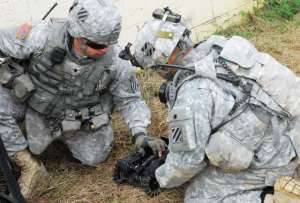
FORT BENNING, Ga. -- Infantrymen and engineers steered four small robots around the buildings and terrain at the McKenna Urban Operations Complex last week to get a better idea how they might help Soldiers in recon missions and the detection of improvised explosive devices.
It was part of the Ultra Light Reconnaissance Robot limited objective experiment sponsored by the Joint Improvised Explosive Device Defeat Organization. Fort Benning's Maneuver Battle Lab conducted the assessment, which began Feb. 13 and ended Friday.
Key players also included the Robotic Systems Joint Products Office; Maneuver Support Center of Excellence from Fort Leonard Wood, Mo.; Maneuver Center of Excellence Counter Improvised Explosive Device training team and Marine Corps Warfighting Laboratory.
Project officials said robot weight, size and power requirements must be measured against its capabilities and limitations in defeating IED threats. Finding the right balance was a major focus area in the experiment.
Army and Marine small units engaged in maneuver, movement and protection operations don't have the responsive capability to detect, identify and monitor IED and other threats in confined spaces such as culverts at standoff distances, officials said. If a possible IED threat is detected but can't be confirmed because of its camouflaged location, small units must call on limited engineer and explosive ordnance disposal resources, or a Soldier has to get close enough to visually confirm the threat -- a time-consuming and dangerous process.
"The point is to keep Soldiers out of harm's way and danger -- and put a robot there instead," said Maj. Joseph Pruitt of the Maneuver Support Battle Lab from Fort Leonard Wood. "Ideally, we want a robot that weighs nothing and does everything."
The candidate robots -- Dragon Runner 10, Armadillo, 110 First Look and Recon Scout -- range from 11 to 1.2 pounds. All are designed to be thrown.
Each was put through its paces in a series of different missions carried out by eight Soldiers from the 3rd Battalion, 7th Infantry Regiment, 4th Brigade Combat Team, out of Fort Stewart, Ga., and eight more from the 428th Engineer Company, 397th Engineer Battalion, a Reserve unit based in Wisconsin.
Product managers and evaluators said they examined various robotic capabilities, including durability, ease of use, weight, range and camera clarity. It supports the MCoE's "Squad: Foundation of the Decisive Force" initiative by advancing possible lightweight robotic technology solutions.
"It's too early to tell how effective they'll be," said Maj. James Collins, the Maneuver Battle Lab's unmanned systems chief. "Soldier survivability is the main thing we want to accomplish. If they will save lives, it'll be very important to field them.
"It's all about the squad right now trying to overpower or overmatch the enemy," Collins said. "Robots have the potential to fill some of these capability gaps at that level."
The lightweight recon robots can be strapped to a Soldier's back. Once deployed on the ground, "anybody who's played Game Boy can pick this up and operate it," said Spc. Jonathon Near of 3-7 Inf.
He said the robots could mitigate casualties by acting as surrogates for U.S. personnel on the battlefield.
"Normally, it would take a fire team to go into a room to see if it or another one is booby-trapped. If you can send a robot instead, it could save lives," Near said. "It lowers the risk of me running out there or sending other guys in to find out what's behind that door or in that culvert."
The Soldiers learned how to put the robots together, employ and disassemble them.
Staff Sgt. Rodolfo Miranda, another Fort Stewart Infantryman, said a couple of robots need minor improvements to better handle the rugged terrain of Afghanistan. But he sees how the systems could be useful downrange.
"Having robots to send out there and do recon for us will definitely save lives on the battlefield," he said.
Collins said the Maneuver Battle Lab will crunch data and assess Soldier feedback as part of a thorough post-experiment analysis. Meanwhile, JIEDDO plans to send the robots into Afghanistan soon for a forward assessment, he said.
US Army
28.02.2012